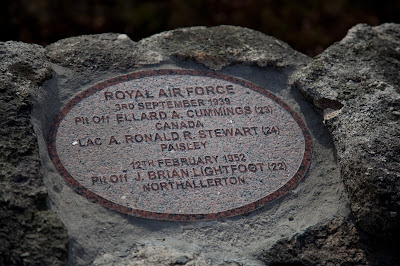Arthur C. Clarke’s Mysterious World – by Duncan Harley
Scattered across the
Aberdeenshire hill-tops are a series of vitrified forts dating back to the
Iron Age. While archaeologists struggle to understand the method of construction
many oddball theories as to their origins abound.
Supporters of the Ancient Astronauts theory believe that the vitrified ruins provide irrefutable evidence that death-rays created by superior outer space beings were used in ancient times to melt granite to form the defensive structures. Others believe that the fusion of solid rock was caused by bonfires lit as part of a religious ceremony or alternatively that fierce attacks by enemy tribes resulted in huge fires which caused the very rocks to melt.
Detractors view the probability of the hill-top forts at Dunnideer or Tap o’ Noth remaining on fire long enough melt rock as unlikely commenting that this would have been “as near as the European Iron Age got to Las Vegas lit against the Nevada desert”.
In an effort to solve the mystery, a full scale combustible model fort was constructed on a council rubbish tip at Tullos Hill in 1980.
Financed by Yorkshire Television, the building and subsequent ignition of the wall was to be aired as part of the Arthur C. Clarke’s Mysterious World science fiction series due for broadcast in the autumn of that year.
Measuring a massive 9 metres in length by 4metres wide, the three metre high structure resembled a funeral-pyre fit for a giant. On the appointed day, and with the addition of an entire articulated lorry load of timber off-cuts, the conflagration was ignited.
As the core temperature rose to a heady 800C, hopes were high that fusion would take place and to aid this, a lorry load of mattresses was added to the bonfire. Whether the ancients would have had access to such items was apparently not an experimental issue.
After 22 hours scientists began sifting through the embers looking for vitrified material. This proved difficult since not only was the structure still smouldering and liable to collapse, but the rubber soled boots worn by the university crew melted due to the heat. By 4pm on April 2, some 48 hours after the experiment had begun, the remains were bulldozed flat and the hunt began for vitrified rock.
In absolute terms, the resulting 3kg of vitrified material located in the ashes was disappointing and the experimental report makes various claims in mitigation of the poor results. The newness of the wall, the lack of suitable hardwoods and the dampness of the firewood were highlighted along with the tight TV production schedule. Critics of the time who pointed out that perhaps the ancients had also suffered from damp firewood, were largely ignored. This was after all a sponsored experiment and was due to be aired on prime time TV later in the year.
The vitrified granite produced during the filming of the Yorkshire Television experiment was eventually deposited at the University of Aberdeen’s Anthropological Museum where remains on display.
Supporters of the Ancient Astronauts theory believe that the vitrified ruins provide irrefutable evidence that death-rays created by superior outer space beings were used in ancient times to melt granite to form the defensive structures. Others believe that the fusion of solid rock was caused by bonfires lit as part of a religious ceremony or alternatively that fierce attacks by enemy tribes resulted in huge fires which caused the very rocks to melt.
Detractors view the probability of the hill-top forts at Dunnideer or Tap o’ Noth remaining on fire long enough melt rock as unlikely commenting that this would have been “as near as the European Iron Age got to Las Vegas lit against the Nevada desert”.
In an effort to solve the mystery, a full scale combustible model fort was constructed on a council rubbish tip at Tullos Hill in 1980.
Financed by Yorkshire Television, the building and subsequent ignition of the wall was to be aired as part of the Arthur C. Clarke’s Mysterious World science fiction series due for broadcast in the autumn of that year.
Measuring a massive 9 metres in length by 4metres wide, the three metre high structure resembled a funeral-pyre fit for a giant. On the appointed day, and with the addition of an entire articulated lorry load of timber off-cuts, the conflagration was ignited.
As the core temperature rose to a heady 800C, hopes were high that fusion would take place and to aid this, a lorry load of mattresses was added to the bonfire. Whether the ancients would have had access to such items was apparently not an experimental issue.
After 22 hours scientists began sifting through the embers looking for vitrified material. This proved difficult since not only was the structure still smouldering and liable to collapse, but the rubber soled boots worn by the university crew melted due to the heat. By 4pm on April 2, some 48 hours after the experiment had begun, the remains were bulldozed flat and the hunt began for vitrified rock.
In absolute terms, the resulting 3kg of vitrified material located in the ashes was disappointing and the experimental report makes various claims in mitigation of the poor results. The newness of the wall, the lack of suitable hardwoods and the dampness of the firewood were highlighted along with the tight TV production schedule. Critics of the time who pointed out that perhaps the ancients had also suffered from damp firewood, were largely ignored. This was after all a sponsored experiment and was due to be aired on prime time TV later in the year.
The vitrified granite produced during the filming of the Yorkshire Television experiment was eventually deposited at the University of Aberdeen’s Anthropological Museum where remains on display.
Duncan
Harley is author of two books about Aberdeenshire. Both titles, The Little
History of Aberdeenshire and The A-Z of Curious Aberdeenshire, are available
from Amazon.











Comments
Post a Comment